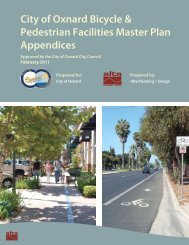Santa Clara River Trail Final Master Plan - Development Services ...
Santa Clara River Trail Final Master Plan - Development Services ...
Santa Clara River Trail Final Master Plan - Development Services ...
Create successful ePaper yourself
Turn your PDF publications into a flip-book with our unique Google optimized e-Paper software.
Chapter 7: Project Implementation <strong>Plan</strong><br />
Transportation, Community, and System Preservation Program (TCSP)<br />
Implementation grants under the TCSP Program provide financial resources to States, metropolitan<br />
planning organizations, local governments and tribal governments to enact activities that address<br />
transportation efficiency, while meeting community preservation and environmental goals. Policy and<br />
program examples include spending policies that direct funds to high-growth regions; urban growth<br />
boundaries to guide metropolitan expansion; and “green corridor” programs that provide access to<br />
highway corridors in areas targeted for efficient and compact development.<br />
Transportation Enhancements (TE)<br />
Potential Transportation Enhancement projects are approved by the VCTC and submitted to the<br />
California Transportation Commission (CTC) for inclusion in the State Transportation Improvement<br />
Program (STIP). This program is funded by a set-aside of Surface Transportation Program (STP) funds.<br />
Ten percent of STP funds are designated for Transportation Enhancement Activities (TEAs), which<br />
include “provision of facilities for pedestrians and bicycles, provision of safety and educational activities<br />
for pedestrians and bicyclists,” and the “preservation of abandoned railway corridors (including the<br />
conversion and use thereof for pedestrian and bicycle trails.” (23 USC Section 190 (a) (35)). The<br />
reauthorization of the Federal transportation bill will determine funding availability for 2012 and later.<br />
TE funding can be used to build projects that enhance bicycle and pedestrian safety, and to build bicycle<br />
and pedestrian facilities. Facility development can include both development of new facilities as well as<br />
modifications of existing facilities. Bicycle facilities must be transportation-oriented (not solely for<br />
recreational purposes), can be located within or outside of the highway rights-of-way and could include<br />
riding or walking surfaces and related amenities. Eligible projects under the safety category include nonconstruction<br />
safety-related activities, such as safety and educational activities. Projects must be<br />
accessible to the general public or targeted to a broad segment of the general public.<br />
Potential Federal Sources<br />
Partnership for Sustainable Communities<br />
Though not a formal agency, the Partnership for Sustainable Communities is a joint project of the US<br />
Environmental Protection Agency (EPA), the Department of Housing and Urban <strong>Development</strong> (HUD),<br />
and the US Department of Transportation (USDOT). One goal of the project is to expand transportation<br />
options that improve air quality and public health, which has already resulted in several new grant<br />
opportunities, including Transportation Investment Generating Economic Recovery (TIGER I, TIGER<br />
II) grants. Oxnard should track Partnership communications and be prepared to respond proactively to<br />
announcements of new grant programs.<br />
108 | Alta <strong>Plan</strong>ning + Design
















